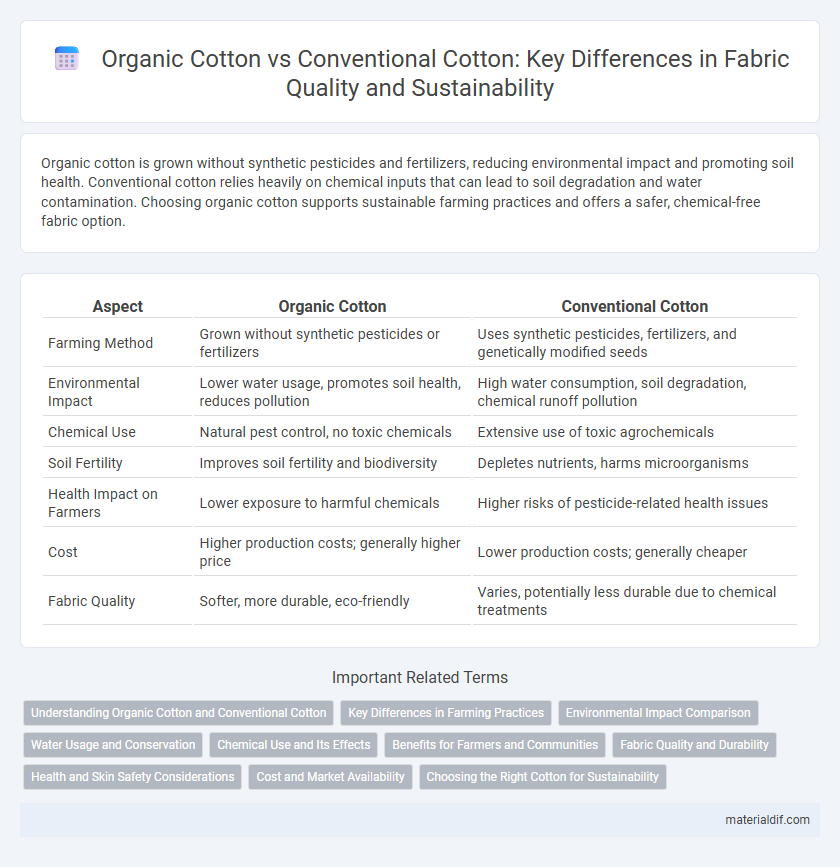Organic cotton is grown without synthetic pesticides and fertilizers, reducing environmental impact and promoting soil health. Conventional cotton relies heavily on chemical inputs that can lead to soil degradation and water contamination. Choosing organic cotton supports sustainable farming practices and offers a safer, chemical-free fabric option.
Table of Comparison
| Aspect | Organic Cotton | Conventional Cotton |
|---|---|---|
| Farming Method | Grown without synthetic pesticides or fertilizers | Uses synthetic pesticides, fertilizers, and genetically modified seeds |
| Environmental Impact | Lower water usage, promotes soil health, reduces pollution | High water consumption, soil degradation, chemical runoff pollution |
| Chemical Use | Natural pest control, no toxic chemicals | Extensive use of toxic agrochemicals |
| Soil Fertility | Improves soil fertility and biodiversity | Depletes nutrients, harms microorganisms |
| Health Impact on Farmers | Lower exposure to harmful chemicals | Higher risks of pesticide-related health issues |
| Cost | Higher production costs; generally higher price | Lower production costs; generally cheaper |
| Fabric Quality | Softer, more durable, eco-friendly | Varies, potentially less durable due to chemical treatments |
Understanding Organic Cotton and Conventional Cotton
Organic cotton is grown without synthetic pesticides or fertilizers, reducing environmental impact and promoting soil health through crop rotation and natural pest control methods. Conventional cotton relies heavily on chemical inputs such as synthetic fertilizers, pesticides, and herbicides, which can lead to soil degradation, water pollution, and biodiversity loss. Organic cotton production typically consumes less water and supports sustainable farming practices, while conventional cotton farming often demands higher water use and contributes to environmental strain.
Key Differences in Farming Practices
Organic cotton farming avoids synthetic pesticides and fertilizers, relying on natural alternatives such as compost and crop rotation to maintain soil health and biodiversity. Conventional cotton farming often depends on chemical inputs and genetically modified seeds to enhance yield and pest resistance but can lead to soil degradation and water pollution. Organic methods typically use less water and promote sustainable ecosystems, whereas conventional practices may strain natural resources and reduce long-term soil fertility.
Environmental Impact Comparison
Organic cotton cultivation significantly reduces environmental impact by eliminating synthetic pesticides and fertilizers, which decreases soil and water pollution. It also typically uses 91% less water than conventional cotton, helping conserve vital water resources and minimizing carbon footprints. Conventional cotton farming contributes to soil degradation and pesticide runoff, adversely affecting biodiversity and ecosystems.
Water Usage and Conservation
Organic cotton typically uses 91% less water than conventional cotton due to rain-fed irrigation and sustainable farming practices. Conventional cotton relies heavily on irrigation, consuming approximately 2,700 liters of water per kilogram of cotton produced, contributing to water scarcity in many regions. Water conservation in organic cotton farming enhances soil health and reduces pollution, supporting long-term agricultural sustainability.
Chemical Use and Its Effects
Organic cotton cultivation eliminates synthetic pesticides and fertilizers, reducing soil and water contamination compared to conventional cotton, which relies heavily on chemical inputs. The absence of harmful chemicals in organic cotton farming supports biodiversity and decreases health risks for agricultural workers. Conventional cotton's chemical use contributes to environmental pollution, including pesticide runoff and soil degradation, impacting ecosystems and human communities.
Benefits for Farmers and Communities
Organic cotton farming reduces exposure to harmful pesticides, promoting better health and safety for farmers and their families. It supports biodiversity and soil regeneration, leading to long-term environmental sustainability and improved crop yields. Communities benefit economically from fair trade practices often associated with organic cotton, fostering social development and improved living standards.
Fabric Quality and Durability
Organic cotton fabric is cultivated without synthetic pesticides or fertilizers, resulting in a softer texture and fewer chemical residues that enhance skin comfort and breathability. Conventional cotton often undergoes intensive chemical treatments that can weaken fibers, reducing fabric durability and causing faster wear and tear. The longer fiber length in organic cotton contributes to stronger yarns, making organic cotton garments more resilient and long-lasting compared to conventional cotton products.
Health and Skin Safety Considerations
Organic cotton is grown without synthetic pesticides and fertilizers, reducing exposure to harmful chemicals that can irritate sensitive skin. Conventional cotton often contains pesticide residues that may trigger allergies or skin reactions, making it less suitable for individuals with eczema or dermatological conditions. Choosing organic cotton supports healthier skin by minimizing contact with toxic substances commonly found in conventional cotton textiles.
Cost and Market Availability
Organic cotton typically costs 20-40% more than conventional cotton due to environmentally friendly farming practices and lower yields. The global market availability of organic cotton remains limited, representing less than 1% of total cotton production, whereas conventional cotton dominates with extensive supply chains and widespread accessibility. Price sensitivity and limited scale challenge organic cotton's market penetration despite growing consumer demand for sustainable fabrics.
Choosing the Right Cotton for Sustainability
Organic cotton cultivation uses natural pesticides and fertilizers, significantly reducing water consumption and soil degradation compared to conventional cotton, which relies heavily on synthetic chemicals. Choosing organic cotton supports biodiversity and lowers carbon emissions, making it a more sustainable option for eco-friendly textile production. Consumers seeking sustainable fabrics should prioritize organic cotton to minimize environmental impact and promote healthier ecosystems.
Organic Cotton vs Conventional Cotton Infographic

 materialdif.com
materialdif.com